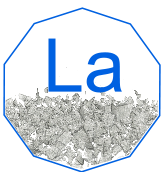Lanthanum

Lanthanum (La)
General Information
- Symbol: La
- Atomic Number: 57
- Atomic Weight: 138.90547 u
- Element Category: Lanthanide (sometimes considered a transition metal)
- Group: 3 (often considered to be part of the Lanthanide series)
- Period: 6
- Block: d-block
Physical Properties
- Appearance: Silvery-white metallic
- Density: 6.162 g/cm³
- Melting Point: 920 °C (1688 °F)
- Boiling Point: 3464 °C (6267 °F)
- Phase at STP: Solid
- Electron Configuration: [Xe] 5d¹ 6s²
- Oxidation States: +3 (most common), +2
Chemical Properties
- Reactivity: Lanthanum is reactive, especially when finely divided. It tarnishes rapidly in air and reacts slowly with cold water and more rapidly with hot water.
- Compounds: Forms compounds such as lanthanum oxide (La₂O₃), lanthanum chloride (LaCl₃), and lanthanum carbonate (La₂(CO₃)₃).
Uses and Applications
- Optical Glass: Used to improve the optical properties of glass and to make special glasses for camera lenses and telescope optics.
- Catalysts: Used in petroleum refining catalysts and in the production of certain types of catalysts for various chemical reactions.
- Lighting: Used in carbon arc lamps for studio lighting and projection.
- Hydrogen Storage: Used in hydrogen storage alloys.
- Batteries: Component in nickel-metal hydride (NiMH) rechargeable batteries.
Occurrence and Extraction
- Natural Occurrence: Found in rare-earth minerals such as monazite and bastnäsite.
- Extraction: Extracted from its ores through processes like solvent extraction, ion exchange, and reduction with fluorine or chloride compounds.
Isotopes
- Stable Isotopes: Lanthanum-139
- Radioactive Isotopes: Lanthanum-138 (used in scientific research)
Safety and Handling
- Hazards: Generally considered to be of low toxicity, but should be handled with care. Finely divided lanthanum is pyrophoric and can ignite spontaneously.
- Precautions: Store in airtight containers to prevent oxidation and handle with appropriate protective equipment.
History
- Discovery: Discovered by Carl Gustaf Mosander in 1839.
- Name Origin: Derived from the Greek word “lanthanein,” meaning “to lie hidden.”
Additional Facts
- Crystal Structure: Hexagonal close-packed (hcp)
- Magnetic Properties: Paramagnetic
- Thermal Conductivity: Moderate, about 13.4 W/m·K
- Electrical Resistivity: About 615 nΩ·m at room temperature
Summary
Lanthanum is a silvery-white, reactive metal with significant applications in optics, catalysis, lighting, hydrogen storage, and batteries. It is found in rare-earth minerals and extracted through various chemical processes. Despite its reactivity, lanthanum is generally of low toxicity but requires careful handling due to its pyrophoric nature.
40 Question and Answer Pairs About Lanthanum
What is the atomic number of Lanthanum?
- 57
What is the symbol for Lanthanum?
- La
What is the atomic weight of Lanthanum?
- 138.90547 u
In which group of the periodic table is Lanthanum found?
- Group 3 (often considered part of the Lanthanide series)
What period is Lanthanum in?
- Period 6
What block does Lanthanum belong to?
- d-block
What is the melting point of Lanthanum?
- 920 °C (1688 °F)
What is the boiling point of Lanthanum?
- 3464 °C (6267 °F)
What is the density of Lanthanum?
- 6.162 g/cm³
What is the electron configuration of Lanthanum?
- [Xe] 5d¹ 6s²
What are the common oxidation states of Lanthanum?
- +3, +2
What is the appearance of Lanthanum?
- Silvery-white metallic
Is Lanthanum reactive with air?
- Yes, it tarnishes rapidly in air.
Name a compound of Lanthanum.
- Lanthanum oxide (La₂O₃)
What is a common use of Lanthanum in optics?
- To improve the optical properties of glass.
How is Lanthanum used in catalysts?
- In petroleum refining and chemical reactions.
What role does Lanthanum play in lighting?
- Used in carbon arc lamps for studio lighting and projection.
How is Lanthanum used in hydrogen storage?
- In hydrogen storage alloys.
What application does Lanthanum have in batteries?
- Component in nickel-metal hydride (NiMH) rechargeable batteries.
Name a mineral that contains Lanthanum.
- Monazite
How is Lanthanum extracted from ores?
- Through processes like solvent extraction and ion exchange.
What is the most stable isotope of Lanthanum?
- Lanthanum-139
Name a radioactive isotope of Lanthanum used in research.
- Lanthanum-138
What safety hazard is associated with finely divided Lanthanum?
- It is pyrophoric and can ignite spontaneously.
Who discovered Lanthanum?
- Carl Gustaf Mosander
Where does the name Lanthanum come from?
- From the Greek word “lanthanein,” meaning “to lie hidden.”
What is the crystal structure of Lanthanum?
- Hexagonal close-packed (hcp)
Is Lanthanum paramagnetic or diamagnetic?
- Paramagnetic
What is the thermal conductivity of Lanthanum?
- About 13.4 W/m·K
What is the electrical resistivity of Lanthanum at room temperature?
- About 615 nΩ·m
What is the primary oxidation state of Lanthanum?
- +3
Is Lanthanum found as a free element in nature?
- No, it is found in minerals like monazite.
What is the common name of lanthanum chloride?
- LaCl₃
What is a major application of lanthanum carbonate (La₂(CO₃)₃)?
- Used in pharmaceuticals to treat hyperphosphatemia.
How does Lanthanum benefit optical glass?
- By improving its refractive properties.
What is the boiling point of Lanthanum in Kelvin?
- 3737 K
What group does Lanthanum belong to in the periodic table?
- Lanthanides (sometimes considered a transition metal)
What is the natural abundance of Lanthanum-139?
- Nearly 100%
Can Lanthanum be used in high-temperature applications?
- Yes, due to its high melting and boiling points.
What is the key property that makes Lanthanum valuable in hydrogen storage?
- Its ability to form stable hydrides.






